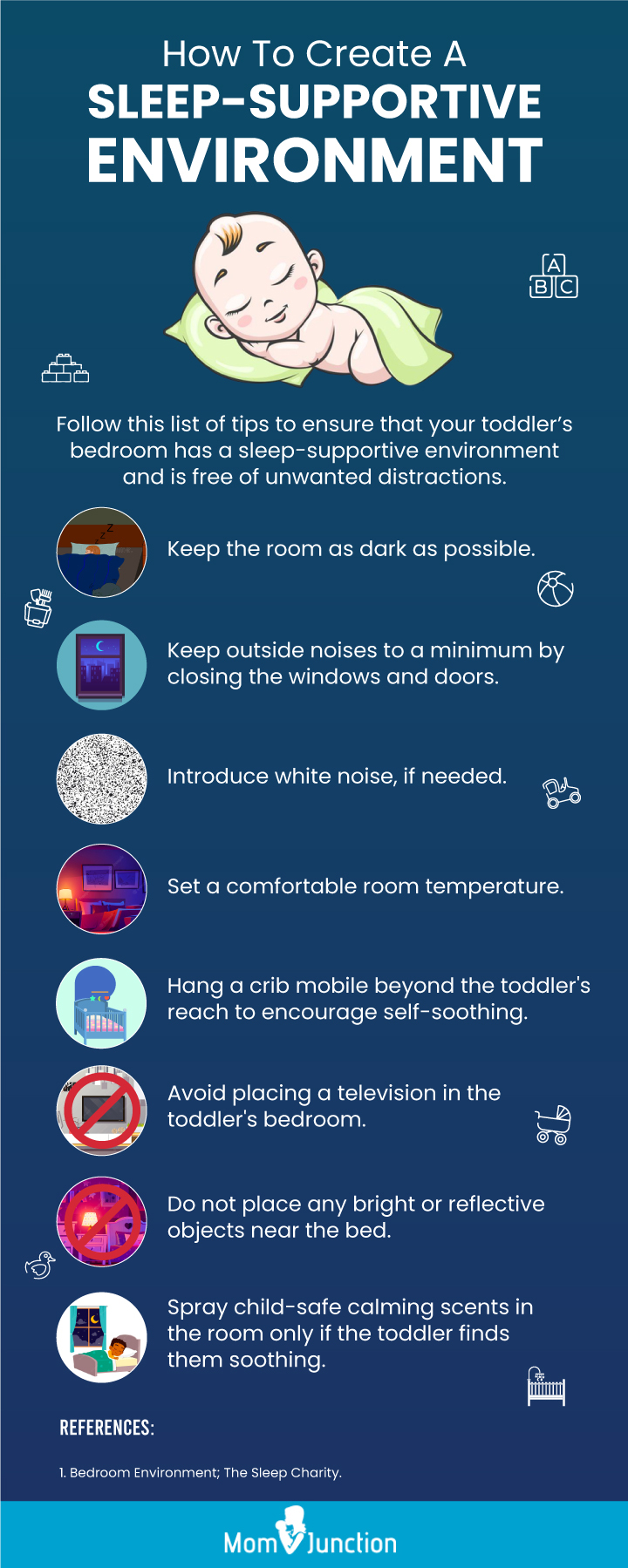
Image: Shutterstock
It is past midnight, and your toddler won’t sleep. They keep giving excuses like they want to pee, that they are hungry, or keep requesting you to read another book. These lines may seem familiar because these may be the common tantrums your child throws to skip sleep.
We understand that you might be exhausted and sleep-deprived. However, there are a few tips that you could try. Here’s more about the cause behind these bedtime tantrums and tips to help put them to sleep.
Reasons Why Toddlers Refuse To Go To Bed At Night
A staggering 22.6% of parents have reported experiencing problematic sleep-related difficulties with their toddlers. It was further established that problematic sleep-related challenges were more pronounced in boys than girls. The following graph shows the spread of sleep-related problems among children of different age groups.
Sleep-related difficulties: prevalence by age and gender
Source: Sleep-related difficulties in healthy children and adolescents; BMC PediatricsThe following is a list of common reasons why your toddler fights bedtime and a full night’s sleep.
1. Hyperstimulation
Hyperstimulation occurs when the toddler is mentally overexcited around bedtime, making it difficult for their mind to calm down enough to fall asleep. Each toddler could be hyper stimulated for different reasons, but common culprits include the following.
- Screen time before bedtime
- Energy-intensive game or activity before bedtime
- Sugary snacks or beverages before bedtime
- Consumption of food items with caffeine, such as chocolates
 Quick fact
Quick fact2. Discomfort
Image: Shutterstock
An undesirable sleep environment could make some toddlers averse to sleeping. Parents can usually find out the cause by inspecting their toddler’s bedroom. Some of the common reasons for toddler’s discomfort in the bedroom include:
- Bright lights
- Loud music or sounds
- Uncomfortable clothes
- Uncomfortable bedding
- Inappropriate room temperature for the weather or season
Discomfort could also be illness-related or health-related. Some of the common reasons include cold, runny or stuffy nose, teething, gas, stomachache, and infection.
3. Curiosity
Some toddlers don’t want to miss any action happening around them and want to see what everyone else is doing at home, making them disinterested in sleep. It is usually more common in households where each family member has a different time for going to bed.
4. Inability to self-soothe
Some toddlers, especially the younger ones, may not fall asleep on their own through self-soothing. Instead, they need to be rocked, patted, cuddled, nursed, or held to sleep.
5. Fears
Toddlers may begin to have scary dreams or nightmares, usually from the age of two years (1). In such cases, the toddler may go to bed without any fuss. However, they may later wake up due to a nightmare and not fall asleep for the rest of the night.
6. Incorrect timing
Going to bed too early when the toddler is not tired enough or too late when they are exhausted and cranky could cause problems with falling and staying asleep. It may not have any impact when it occurs once in a while. However, if you always observe incorrect timings, it could interfere with the toddler’s sleep.
7. Playfulness
Image: IStock
Toddlers are very active and playful. They may cry before sleeping as they don’t want the day to end and want to play for a little longer.
Dr. Lynelle Schneeberg, Fellow of American Academy of Sleep Medicine, Assistant Professor at Yale School of Medicine, and a licensed clinical psychologist says, “For kids, going to sleep is much more boring than playing and spending time with mom/dad so they will resist on that basis alone.”
8. Separation anxiety
Separation anxiety peaks between nine and18 months and begins to fade away at around two years of age (2). Until then, not getting to see you around or waking up to find you out of the room can make a toddler very upset.
9. Lack of a bedtime routine
Children thrive on routine, and a good bed time routine signals that it is time to sleep now. A good bedtime routine will keep them calm, quiet, and relaxed (3).
“If a child learns that he or she can delay the bedtime routine by throwing a tantrum, the child will often try doing this more often since it “pays off.” And if the routine doesn’t start at the same time, each night, this can become a point of contention,” says Dr. Schneeberg.
10. Milestones
The toddler may have trouble falling asleep when they are learning new things or reaching new milestones. It usually happens due to the toddler’s desire to experiment with new achievements and milestones, leading to disinterest in sleep or disturbed sleep.
11. Dropping naps
As a toddler grows, their total sleep duration tends to reduce. They begin to drop a few naps per day as they adjust to the new total sleep duration. This transition may interfere with nighttime sleep.
 Quick fact
Quick fact12. Sleep apnea
Sleep apnea interferes with breathing during sleep, causing the toddler to awaken at night frequently. It leads to sleep disturbances and the inability to fall asleep (4). Signs of sleep apnea can include snoring, pauses in breathing while sleeping, chronic mouth-breathing, and teeth grinding.
 Things to know
Things to know13. Sleep crutches
Image: Shutterstock
Most children have sleep crutches, which are also known as sleep-onset associations. These are objects, such as a sleep lovey, that help a child fall asleep. A few examples of sleep crutches include snuggling with a toy before going to sleep. Some sleep crutches involve a parent. For example, nursing to sleep or being rocked to sleep are also sleep crutches.
“If the sleep crutch does involve a parent and if the child can’t count on the parent “delivering” the crutch in a reliable way (for example, if dad has to lie down with the child instead of mom or if mom doesn’t have time to rub the child’s back one night), the child will throw a tantrum,” explains Dr. Schneeberg.
Unavailability of such dependencies could cause tantrums at bedtime. You may consider giving your children their favorite toy or soft toy at bedtime if it helps them feel secure.
Getting A Toddler To Sleep Through The Night
You may consider the following measures to improve your toddler’s sleep cycle and get them to go to bed at night with minimal fuss (5)(6).
1. Make a bedtime plan
Mary Vaughn, a certified sleep consultant from the Institute of Pediatric Sleep and Parenting, states, “Bedtime for toddlers should be consistent and predictable so your child knows what to expect. A great bedtime routine includes a wholesome and balanced bedtime snack to stave off hunger, brushing teeth and using the bathroom, pajamas, and then a combination of quiet, calm, parent-child bonding activities to wind down for the night. They should understand that the routine ends with a kiss goodnight and sleep.”
Giving more choices to the children can help as it makes them feel that they are in control of bedtime. Asking for their opinions on simple things, such as “Would you like to go potty or brush your teeth first?”, “Do you want your tiger pajamas or the unicorns?”, or “Should we read two books or three?”, can help establish a smooth bedtime routine, states Vaughn.
You can also consider listing down the things that need to be done in a sequence. Place self-explanatory stickers on a chart or use pictures for toddlers who can’t read yet. Repeating this plan daily will make it easier for your toddler to cooperate with you and internalize it.
2. Stick to the routine
A consistent bedtime routine provides toddlers with a sense of security since they prefer things to be predictable. It is ideal for a toddler to go to sleep and wake up at the same time daily. This rhythm should not be disturbed even on weekends. Toddlers need 10-12 hours of sleep every day. Fix their bedtime in a way that won’t disturb their school timings and let them sleep for the necessary hours.
3. Enjoy quality family time
Image: IStock
Toddlers may show more attention-seeking behavior during bedtime as they long for attention and love from their parents or caregivers who might have been busy with work during the day. Talking to your toddler about their day, singing to them, or reading a book can soothe them and ensure a happy bedtime.
4. Reduce the screen time
Light from electronic devices, including television and phones, stimulates the brain and makes falling asleep difficult. It inhibits the production of melatonin and serotonin, the hormones responsible for inducing sleep. Toddlers should be away from electronics for two hours before bedtime to ensure they calm down adequately before going to bed.
5. Create a sleep-supportive environment
A cozy bed, dim lights, ideal temperature, and comfortable clothes are a few factors that help in creating an ideal bedtime atmosphere. It is essential to separate the bed as a spot for sleep and not a place to play. Nevertheless, you may provide the toddler a preferred soft toy to help them feel secure and ease separation anxiety. However, make sure none of the toys are choking hazards.
6. Positive reinforcement
Since younger toddlers may not know how to read time, you can buy special color-changing clocks. You may fix the sleep time and wake up time colors and encourage the toddler to follow the same. You can consider using stickers to reward them when they follow their sleep and wake-up schedules.
If your toddler does wake up at night for some reason, do not scold or punish them. Punishment could lead to a negative association with sleep and bed. Instead, be calm and check for the possible cause of the sleep disturbance.
7. Helping with nightmares
Image: Shutterstock
Nightmares or night terrors can be frightening for toddlers as they cannot distinguish between real and fiction. It’s okay if the toddler wakes up and wants to be with you for a while. You can comfort them and put them back to bed once they have calmed down (7).
If they remember the nightmare in the morning, explain to them that nightmares are a product of their imagination. The occasional nightmare is normal and may be the child’s way of processing changes and difficulties. However, if your child is having recurrent nightmares, consider talking to a counselor experienced in working with dreams and sleep issues. Also, nightmares that begin after a frightful event may be a sign of post-traumatic stress disorder and require further care.
Frequently Asked Questions
1. Is it normal for a toddler to not want to sleep?
It’s normal for toddlers to temporarily show disinterest in sleeping. According to research, approximately 25 to 30% of toddlers experience sleep problems. Behavioral sleep problems, such as difficulty falling asleep independently, are the most common sleep problems in toddlers (8). If your toddler’s sleep doesn’t improve even after trying different techniques, consult a doctor. Identifying the cause can resolve the issue and help your child develop a healthy bedtime schedule.
2. Do overtired toddlers sleep less?
According to experts, a toddler can experience sleeping issues, such as waking up frequently or having difficulty falling asleep if they are overtired at bedtime (9).
3. How long can a two-year-old stay awake?
Toddlers usually need 10 to 12 hours of sleep at night and one to two hours during the day (10). Thus, they may stay awake for an average of five to six hours during the day. However, this may vary from one toddler to another.
Most parents are constantly concerned regarding the nighttime tantrums of their toddlers. Knowing why your toddler won’t sleep and tips for coping with this situation could help. For example, hyperstimulation, undisclosed fears, desire to play, certain medical conditions, and uncomfortable bedding could make your toddler refuse to go to bed, leading to sleep disturbances. You may try implementing a good nighttime routine, minimize screen time, and encourage them with rewards to follow a sleep routine. If you are concerned about your toddler’s sleep problems, you may speak to a healthcare provider.
Infographic: How To Prepare A Toddler’s Bedroom For Bedtime?
It is important that you make your toddler’s bedroom or sleeping area sleep-friendly and free of any distractions to ensure that they do not have any disturbances while they sleep. This infographic contains a few tips that will help you achieve the same for your little one. Scroll through, and do not forget to save it. Illustration: Momjunction Design Team
Get high-quality PDF version by clicking below.
Download Infographic
Key Pointers
- Screen time before bed, uncomfortable clothing, playfulness, and fear may be some reasons why toddlers refuse to sleep at night.
- A good bedtime plan and a consistent routine can help children sleep comfortably through the night.
- Having a fun family time, creating a supportive environment, and some other sleeping tips for toddlers as you scroll through
References:
2. Emotional and Social Development 8 to 12 Months; AAP
3. Sleep and Children; UCLA Health
4. Types of Sleep Disorders in Children; NYU Langone Hospitals
5. How to help your kids get a good night’s sleep; Stanford Children’s Health
6. Healthy Sleep Habits How Many Hours Does Your Child Need?; AAP
7. Bedtime Routines for Children; Sleep Foundation
8. Jonika B. Hash et al.; Sleep Patterns, Problems and Ecology among Toddlers in Families with a Child Protective Services Maltreatment Referral; NCBI
9. How to survive nights when your toddler keeps waking up; NCT
10. Toddler sleep: what to expect; Raising Children
11. Screen time and Children; MedlinePlus
12. Naps; Johns Hopkins Children’s Hospital





















